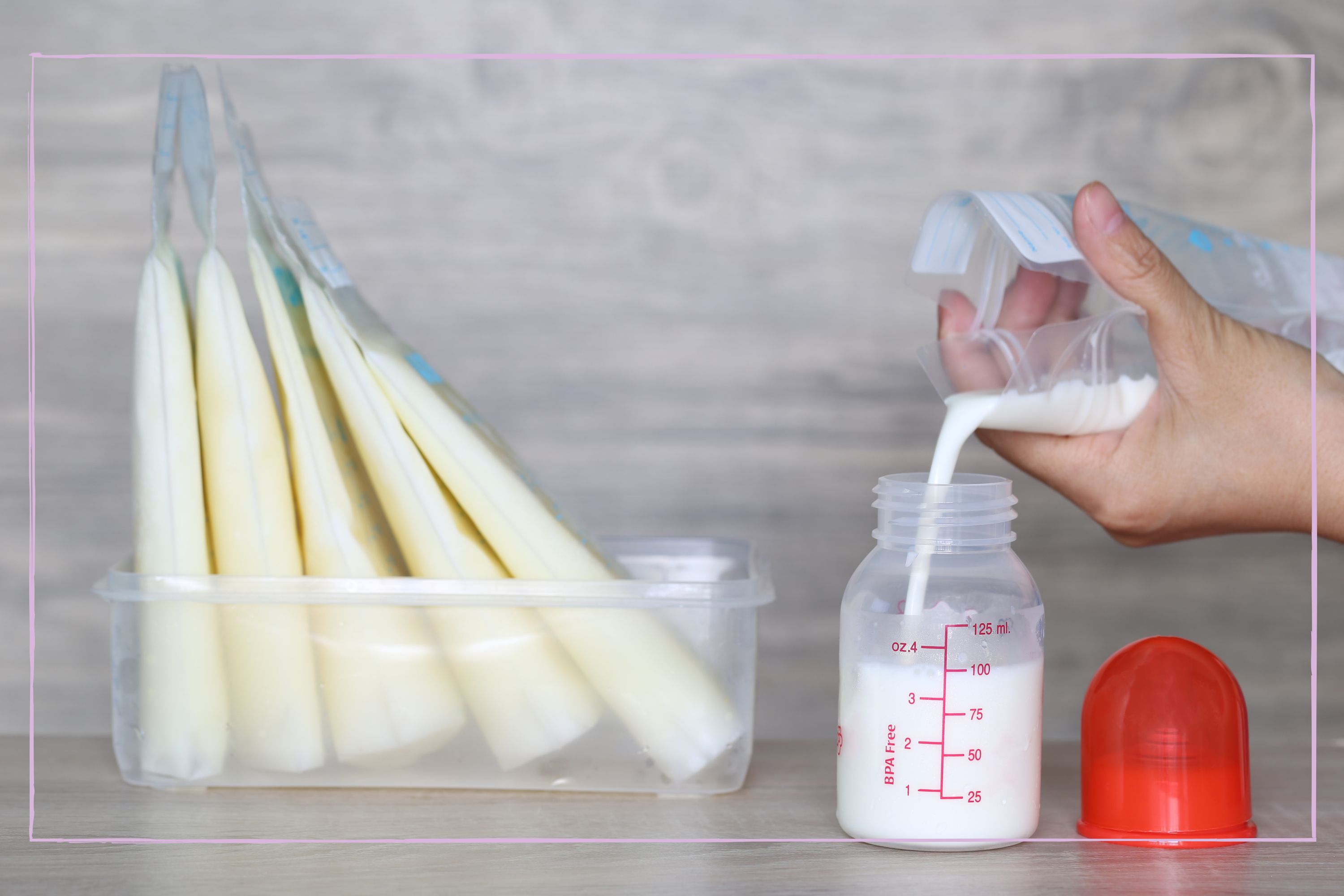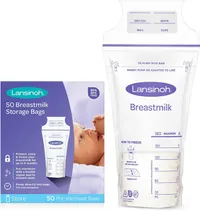
How to store breastmilk is one of the many 'how do I...?' questions that parents face, so we spoke with the experts to find out the best way to do it.
We do so much of our adult life on autopilot because we can, we know how to do it. But, have a kid and all of that goes out the window. No autopilot around while you navigate all the newness that comes with becoming a parent and keeping a tiny human being alive and nurtured.
For some women, breastfeeding or using breastpumps can be one of the most difficult things to get to grips with after the birth of their baby. If a comfortable latch can’t be established some mothers choose to combi-feed with formula or to express their breast milk and bottle feed instead. Lansinoh’s resident midwife Jo Parkinton says: “Should breastfeeding not work for mum and baby, then expressing is the next best thing, as baby will still get all the brilliant benefits from the breast milk.” And of course, breast milk storage is a very important part of the process - you don’t want all of that hard work to go to waste!
How to store breastmilk?
The two main ways of storing breast milk is in the fridge or freezer. Milk pumped then left on your kitchen side can last for up to four hours, after that it needs to be dumped, also known as poured away. "You have up until those four hours is finished to decide fridge, freeze, or feed" mom-of-three, Jasmine tells us.
Giving your baby expressed milk means they’re not missing out on the vital nutrients it contains. Breast pump technology has really improved in recent years which means women can express their milk while on the move in a much faster and more discreet way. A 2011 study published in the American Journal of Public Health stated that: “Milk expression has been an important strategy that women have used to combine breastfeeding with employment and use of child care.”
Jo Parkinton, who has been a midwife for 28 years, says it’s important to store your breast milk safely to keep your baby safe and ensure they’re getting all the nutrients they need. “Breast milk is suitable for storing due to its antibacterial properties, which help it to stay fresh and discourage the growth of bacteria,” she says.
Best storage containers
Storage of breastmilk is a serious business, your best Tupperware won't cut it. According to the CDC only use breast milk storage bags or clean, food-grade containers to store expressed breast milk. In addition, ensure any containers you choose are made of glass or plastic and have tight fitting lids.
Parenting advice, hot topics, best buys and family finance tips delivered straight to your inbox.
Avoid bottles with the recycle symbol number 7, which indicates that the container may be made of a BPA-containing plastic - BPA-free plastic is what you're looking for. Jasmine, breastfed her two boys and tells us the best bags she found; "bulk buying the Lansinoh bags was the best thing I did. They're so strong and durable. You can label them which is really handy. They freeze flat which is great for saving space and have a double seal which stops any milk from escaping. They have amounts on the side which can be handy when you’re bagging them - don’t want to freeze more than baby can drink and waste it."
Fridge Storage
Expressed milk can be stored in a fridge for up to eight days at 4°C or lower. If you’re not sure of the temperature of your fridge, the NHS recommends you use the milk within three days.
You can't, according to studies from the CDC, mix warm and cold breast milk together. Mixing freshly expressed breast milk with already cooled milk can rewarm the older stored milk which can cause bacteria to grow. It is best to cool freshly expressed milk before combining it with older, previously cooled, or frozen milk.
Freezer storage and how to defrost
You can store breastmilk for two weeks in the ice compartment of a fridge and for up to six months in a freezer, if the temperature is -18°C or lower. The best way to defrost breast milk is to put it in the fridge where it can defrost slowly. If you’re short of time, you can put the storage bag into a jug of warm water or run it under the hot tap. You’ll probably notice that the milk has separated a bit but this is normal. If you shake it up it should be fine.
If you are taking breast milk that was stored in the fridge out and about with you, it’s safe to use it within 24 hours if kept cool with ice packs. It is not safe to reuse breast milk that has been left out longer than 2 hours. Dispose of it if this is the case. Breast milk should never be re-refrigerated or re-frozen.

Scientists have proven that temperature does not affect the nutritional composition of milk, babies can drink cold milk. Some babies may drink the breast milk cold and straight from the fridge but others may need it to be warmed up. Again you can do this by putting a sterilized bottle in a jug of warm water or running it under warm water. Microwaving milk is not recommended for babies because it can cause hot spots which can burn their mouths. This is important if you are feeding them formula or breast milk.
If your baby is in hospital and you’re taking in expressed milk for them or you’re expressing there, you will need to speak to the staff about storing your milk as the rules may be more strict. Expressing even if your baby is premature or too ill to feed directly from you can help you build up your supply, and give them the key nutrients they need to build up their immune systems. Breastmilk really is magical stuff so if expressing means you can feed it to your baby for longer then it’s a great choice to make.
Why choose to express milk?
There are a number of reasons why women may choose to express their breast milk and luckily there is a pump on the market for all budgets these days. Mums might want their baby to take a bottle so their partner, or other family members, can share the feeds. Their baby might need special care in hospital which means they are unable to breastfeed but can still be fed breast milk via a tube. As mentioned above, some women find breastfeeding difficult, whether this is due to issues with latching, tongue tie or nipple pain. If you’ve had twins or triplets you might choose to bottle-feed expressed milk because babies can be fed at the same time and other people can help you. It’s also easier to monitor how much your baby is drinking, which can be important if they’re gaining weight more slowly than expected.
Giving your baby freshly expressed breast milk is preferable to refrigerated milk, but refrigerated is better than frozen. This is because freshly expressed milk has the best bacteria-fighting properties and is higher in antioxidants, vitamins and fat. It’s best to freeze your milk as soon as possible after it has been expressed.
Some parents may choose not to breastfeed because they find it painful or they may struggle to latch their baby. Everyone will have a different experience but it’s not often as simple as it looks in adverts or films. This 2022 study of breastfeeding women in KInshasa in the Democratic Republic of the Congo found that the first four weeks after birth are when most problems occur. “Most of these problems might be prevented with optimal breastfeeding technique and by emptying sufficiently and frequently the breasts. Therefore, breastfeeding mothers should be supported as soon as possible after delivery, to improve their breastfeeding technique and to be informed on how to maintain breast milk supply.”
The Pitcher method
Mom-of-one, Ashley Inman took to her TikTok account to share her 'pitcher method' with her 14.4k followers. She talks about how she stores her breastmilk for son, Holden. Talking to camera over a sped up video she explains that she stores all the milk she pumps over a course two or three days into a pitcher, and once full she pours out into measured bags and freezes it in 5oz portions. Ashley is quick to remind moms to label the baggies of milk with the first day she started filling the pitcher, not the last day.
Top breastmilk storage buys
If you’re planning to express regularly in order to build up a good supply in your freezer, there are a few items you might want to buy first. We recommend an electric pump as this will speed up the expressing process and give you more time with your baby and for other activities. You will need to sterilize the pump before and after you used it so you will need either a sterilizer or sterilizing tablets. Containers for the expressed milk should be BPA-free and also need to be sterile, or you can buy sterile milk storage bags. It’s sensible to label the bags with the date the milk was expressed and the volume. Sleep-deprived brains need life to be as simple as possible!
- Electric Breast pump
- Sterilizer or sterilizing tablets
- BPA-free storage bags or containers
- Permanent markers/stickers to date milk
Philips Avent Electric Breast Pump | Amazon
RRP: £277| Delivery: FREE | Refundable: FREE 30 days
This was reviewed and rated as best to invest in overall, by Goodto.com parent reviewers. Read the review.
Whether you choose breast or bottle, the main thing to remember is that 'fed is best'. You know your baby, your family and your circumstances better than anyone else, it's your choice.
Related features:
- When and how is best to stop breastfeeding?
- Breastfeeding bras - tried tested and reviewed
- Best breastfeeding positions
Video of the Week:
- Empty list

Kat has been a digital journalist for over 15 years after starting her career at Sky News where she covered everything from terror attacks to royal babies and celebrity deaths. She has been working freelance for the last five years and regularly contributes to UK publications including Stylist, ES Best, Woman&Home, Metro and more.


